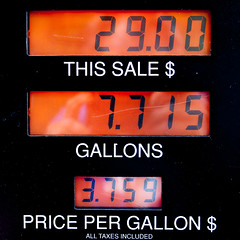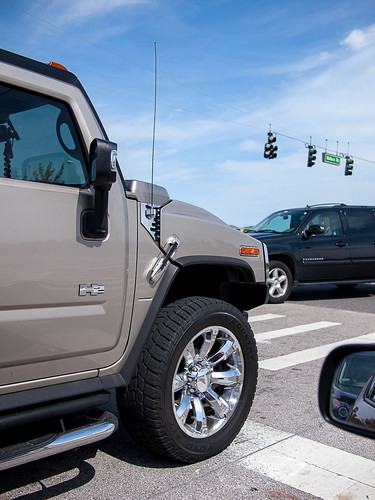Grow Up
 It's now open season on President Obama from every presidential candidate in the Republican party, along with his or her legislative lackeys. The rising cost of gasoline is one of a number of attack fronts that the GOP is concentrating on. The basic GOP pitch is it's all Obama's fault.
It's now open season on President Obama from every presidential candidate in the Republican party, along with his or her legislative lackeys. The rising cost of gasoline is one of a number of attack fronts that the GOP is concentrating on. The basic GOP pitch is it's all Obama's fault.I certainly don't like the rising cost of gasoline, and neither does U.S. Rep. Allen West, the congressional republican representative for Florida's 22nd congressional district. Poor old representative West was so incensed that he had to spend $70 to fill up his 2008 Hummer 3 a few weeks back that he posted his displeasure on his Facebook page.
What kind of H3 model does the good Mr. West drive? The only clue we have is it's a 2008 model, so I'm going to make a few assumptions.
 |
| Gas-guzzlers everywhere... |
2008 is a special year for two reasons. The first reason: in 2008 GM attempted to address the power problem by giving the H3 a 5.3 L, 300hp V8 engine. That dropped the 0-60 time down to around 8 seconds and dropped the H3's mpg to 13mpg city/16mpg highway. Oh, and the H3 has a 23 gallon tank, which doesn't really go very far with that thirsty V8.
So let's do a little math here. After all, regardless of the engine the tank is still the same size. Last week, gas in Orlando cost $3.66. If we were to fill a H3's tank with gas, it would've cost 23 gallons × $3.66 or $84.18. That's pretty close to West's $70 fill-up cost. Working back, that means he either didn't fill an empty tank (say, 19 gallons or so), or else the price the week before was cheaper still (a little over $3/gallon). Since we hit January with gas prices well above $3, I'm assuming he didn't fill a near-completely empty tank.
As I've written before, I drive a 2009 Prius. We got it when the price had dropped down a bit in early 2009 because of the bad economy. We also got it because it was the only car that approached anywhere near 40 mpg aggregate driving. As I later discovered, it could easily attain 55 mpg on the highway at driving speeds around 60mph, which was quite impressive. Three years on and the Prius, with nearly 65,000 miles on it, is still attaining about 52mpg. The mileage dropped when I put a different set of touring tires on the vehicle, choosing to "burn" some of that efficiency for a better gripping tire in wet weather (we have a lot of wet here in Florida during the rainy season).
The price you see above is what I paid after eight days of driving (last Friday to today, Saturday). With all my commuting between home and Research Park near UCF, I burn a little less than a gallon/day. Even if I were to completely fill the Prius (10 gallons), I'd still come out ahead of any Hummer.
The second reason 2008 is so special: What I find rather mind-boggling is West bought his H3 in 2008, the year when prices spiked incredibly high due to speculation in the commodities markets. By July 7th 2008, crude hit $147/barrel and gasoline hit $4.11/gallon. With all that pain at the pump, where the hell was West? With his brand-new Hummer he would have paid more then than now. And did he blame Obama for that spike then?
But I'm not above trying to help anyone, even a republican. So to help Mr. West find a better set of wheels, a more socially responsible set of wheels, I've copied this convenient chart, prepared by Consumer's Union, of current autos that achieve realistic highway mpg of 40 or greater. It's that third column that is interesting, because that's what Consumer's Report achieved driving the vehicles at 65mph. Four of them are domestic (I've highlighted them for you), made by Ford (sorry, no GM in the list). What's interesting by its absence are any Hyundai models, such as the Elantra and the Accent.
| Make & Model | EPA Highway MPG | CR Highway MPG | Difference (mpg) |
| Honda Civic LX | 39 | 47 | 8 |
| Honda Civic EX | 39 | 43 | 4 |
| Ford Fiesta SE sedan | 39 | 45 | 6 |
| Ford Focus SE | 38 | 43 | 5 |
| Toyota Camry Hybrid XLE | 38 | 43 | 5 |
| Fiat 500 Sport (manual) | 38 | 42 | 4 |
| Fiat 500C Pop (manual) | 38 | 42 | 4 |
| Nissan Versa SV sedan | 38 | 40 | 2 |
| Honda CR-Z EX (manual) | 37 | 45 | 8 |
| Ford Fiesta SES hatchback (manual) | 38 | 42 | 4 |
| Mini Cooper (manual) | 37 | 41 | 4 |
| BMW 335d (diesel) | 36 | 40 | 4 |
| Ford Fusion Hybrid | 36 | 40 | 4 |
| Toyota Camry LE | 35 | 41 | 6 |
| Mazda2 Sport (manual) | 35 | 40 | 5 |
| Toyota Corolla LE | 34 | 40 | 6 |
| Scion xD (manual) | 33 | 40 | 7 |
So why have gasoline prices risen this time? In a word, markets. Gas has been so high for so long that we've been buying more fuel efficient cars and trucks (see chart above) to avoid spending so much money at the pump. The transition isn't complete (see all those Hummers, Suburbans, etc still on the roads), but it's getting there. Our demand for gasoline is at a 15-year low. Who was in office 15 years ago? That would be 1997, and Bill Clinton, another Democrat.
Because we're buying less and less gasoline, and certain inefficient refineries on the east and west coast can only process the very expensive Brent crude, the operators are caught in a financial squeeze: unable to pass prices along to customers, they've been forced to shut these inefficient refineries down. Which, ironically, forces up the price of gasoline even further because the only refineries left in business are those in the mid-west refining cheaper but dirtier West Texas Intermediate, primarily from oil shales, the Gulf, and North Dakota (North Dakota???), which just passed Ecuador in its output.
When you cut refinery output wipe out any savings from an over-supply. When your refineries in the mid-west are a good thousand miles from your markets on both coasts transportation costs add to final price at the pump.
What's even more interesting is that we actually exporting quite a bit of refined gasoline out of the country to markets that pay as much or more than we do for gas. All because we're producing more than we use, and so the markets (South America, China, etc) are soaking it all up. And that adds to U.S. pricing pressure as well. The U.S. isn't independent in the oil market, we're a part of it.
All of this is due to unfettered market forces. Don't you love it when the marketplace works the way it does? You should be if you're a republican.
 |
| As true now in 2012 as it was in 2005 when this was drawn |

Bill> "...the rugged undeveloped country in his district, especially around West Palm Beach."
ReplyDeleteHahaha - cracked me up, man!
Bill... there is yet another reason why gas has gone so high. For the third time in three years we have devalued our currency ("Quantitative Easing") This means our dollars are worth less, and anything we import will cost more.
ReplyDeleteSince we import 75% of our oil now, then the exporting nations will want more of the cheaper dollars for each barrel of oil they sell us.